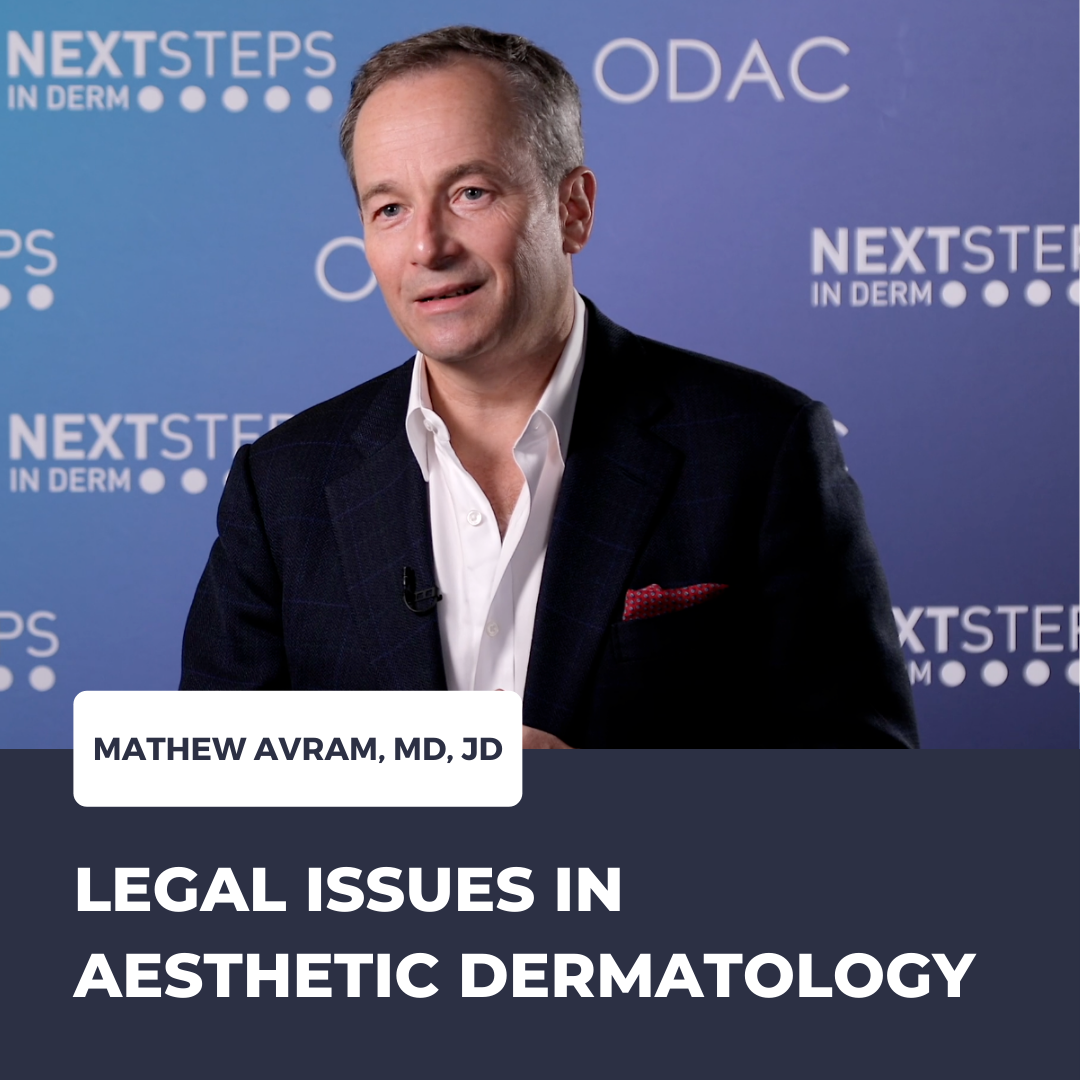Next Steps in Derm, in partnership with ODAC Dermatology, Aesthetic and Surgical Conference, interviewed Dr. Mathew M. Avram (Director of the Mass General Dermatology Laser & Cosmetic Center and Director of Dermatologic Surgery at MGH, as well as Faculty Director for Procedural Training in Harvard Medical School’s Dermatology Department), who discusses potential legal situations that may arise in aesthetic dermatology, two very important legal doctrines, malpractice law and informed consent, how to address adverse events, and the importance of speaking to colleagues when these arise. Watch as he advises from the perspective of both the patient and the physician.
Further Reading
 Medical Bioethics in Dermatologic Procedures
Medical Bioethics in Dermatologic Procedures
ABSTRACT
The US Food and Drug Administration (FDA) held a hearing on the safety of dermal fillers in November of 2008 which generated a great deal of media attention and, more importantly, got our attention. The adverse reporting data came from the FDA’s Manufacturer and User Facility Device Experience (MAUDE) database and numbered 930 cases over the past 6 years, bringing the complication rate to an estimated 1 in 10 000. Some of the complications were severe, such as facial palsy or anaphylaxis; while others included scarring. Such rare but grave complications are generally considered acceptable risks for treatments of medical illnesses (eg, infections or carcinomas); but are these rare complications for elective cosmetic enhancement acceptable? Read the full article here.
 Cosmetic Practitioners Take Huge Risks Purchasing and Administering Illegal Botulinum Toxin Drug Products
Cosmetic Practitioners Take Huge Risks Purchasing and Administering Illegal Botulinum Toxin Drug Products
ABSTRACT
In their article “Importing Injectables” in the September 2014 issue of the Journal of Drugs in Dermatology, Dr. Kenneth Beer and Karen Rothschild highlighted the possible harm to patients and practitioners from the use of unapproved botulinum toxin products – eg, Botox, Dysport, Xeomin, and Myobloc – and other cosmetic prescription drug products purchased from foreign or unlicensed suppliers.1 In the intervening years, the accuracy of their critique has been repeatedly demonstrated, as the dangers to patients’ health, as well as to cosmetic practitioners’ liberty, has only increased. Read the full article here.
 Improving Consent Procedures and Evaluation of Treatment Success in Cosmetic Use of IncobotulinumtoxinA: An Assessment of the Treat-to-Goal Approach
Improving Consent Procedures and Evaluation of Treatment Success in Cosmetic Use of IncobotulinumtoxinA: An Assessment of the Treat-to-Goal Approach
ABSTRACT
Background: Despite the escalating number of patients undergoing aesthetic BoNT-A procedures, a standardized, objective means of setting treatment goals and measuring the success of treatment is lacking. Treat-To-Goal (TTG) is a new approach to consent that utilizes the Merz Aesthetics Scale to set objectively defined start points and treatment goals to better inform the consent process and provide a means of measuring the success of treatment.
Objective: To evaluate the TTG approach vs standard consent procedures in terms of patient understanding of the risks and benefits of treatment.
Methods: This study was undertaken in 2 phases among consecutive patients presenting for BoNT-A treatment. Phase 1 consisted of a crossover comparison of patient satisfaction with standard consent vs the TTG approach (n=20). Patient understanding of the likely outcomes and risks associated with treatment following consent and their overall preference were assessed using 10-point visual analog scales (VAS). Phase 2 assigned patients to receive no treatment (n=10) or treatment with BoNT-A (n=54) following consent with the TTG approach. Patients were followed up with 28 days later to assess whether the goals defined during consent had been met.
Results: The TTG approach significantly improved patient understanding of likely outcomes of BoNT-A treatment compared with standard consent (P=.004 when standard consent assessed first, and P=.002 when TTG assessed first). All patients assessed preferred the TTG approach (median VAS score in favor of TTG: 7.0, P<.0001). Target improvements were successfully met or exceeded in at least one treatment area (forehead, glabellar lines, crow’s feet) in all patients treated with BoNT-A. In contrast, none of the untreated patients met their target improvements unless the target was defined as no change.
Conclusion: The TTG approach represents a significant improvement over standard consent in terms of the information it provides to patients. Further investigation of this concept is warranted.
About Dr. Mathew M. Avram
 Dr. Avram attended college at Princeton University and completed his dermatology residency training at Harvard, where he served as chief resident. Subsequently, he completed his Mohs micrographic surgery, laser & cosmetics fellowship at UCLA. Dr. Avram serves as the President of the American Society for Laser Medicine & Surgery (ASLMS) for 2017-2018. ASLMS has more than 4,000 physicians, scientists, and others among its membership. Elected as Treasurer of the American Society for Dermatologic Surgery (ASDS), he also serves on their Executive Committee. Dr. Avram was the recipient of the ASLMS 2015 Annual Leon Goldman Award for excellence in research, patient care and education. In, 2016, he was recipient of the ASLMS Annual Ellet Drake Award for innovation in laser surgery.
Dr. Avram attended college at Princeton University and completed his dermatology residency training at Harvard, where he served as chief resident. Subsequently, he completed his Mohs micrographic surgery, laser & cosmetics fellowship at UCLA. Dr. Avram serves as the President of the American Society for Laser Medicine & Surgery (ASLMS) for 2017-2018. ASLMS has more than 4,000 physicians, scientists, and others among its membership. Elected as Treasurer of the American Society for Dermatologic Surgery (ASDS), he also serves on their Executive Committee. Dr. Avram was the recipient of the ASLMS 2015 Annual Leon Goldman Award for excellence in research, patient care and education. In, 2016, he was recipient of the ASLMS Annual Ellet Drake Award for innovation in laser surgery.
Did you enjoy these video pearls? Find more here.

